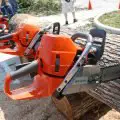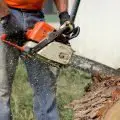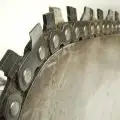Even if you use a chainsaw on occasion or frequently, you could experience the issue of a flooded chainsaw. Finding out how to start a chainsaw that has flooded is essential for this reason. It cannot start when the fuel overloads and overflows the combustion chamber. A flooded chainsaw is what it is known as. The spark is ignited inside the combustion chamber.
However, if the fuel level in the chamber rises too high, oxygen cannot exist there. As a result, the chainsaw cannot start and floods. Cleaning the chamber on a regular basis is one technique to avoid this issue. Will a chainsaw that has been flooded, however, be able to fix itself? “No,” is the response. So let us walk you through how to start a chainsaw that has been flooded.
Table of Contents
- Signs of a Flooded Chainsaw
- How to Unflood a Chainsaw and Start It
- Unflooding a Stihl Chainsaw
- Starting a Flooded Husqvarna Chainsaw
- FAQs (Frequently Asked Questions)
Signs of a Flooded Chainsaw
The smell of gasoline coming from the muffler is one indication that a chainsaw has been flooded. It is obvious that you should check into how to start a flooded chainsaw motor because of the strong gasoline odor and difficulty starting.
Overfueling the engine prevents the fuel from igniting, which leads to flooded chainsaws. Consider how fuel and oxygen are required for combustion within an engine. When the spark plug attempts to ignite the gas, there isn’t enough room since there is too much fuel.
You have to repeatedly pull the chainsaw’s starter cord in order for it to start since the spark plug needs air to ignite the gas. The heavy smell of gasoline emanating from the chainsaw is another sign that it has been flooded.
Why Did Your Chainsaw Become Flooded?
Most likely, you over-choked the saw and flooded it. This can occur if the choke is used when the saw is not in the run position or if the choke is used inappropriately on a warmed-up motor. When you pull out the choke lever on some chainsaws, they instantly go to the run position. Although this is a convenient feature that reduces some user mistakes, not every chainsaw or small engine is equipped in this manner.
Additionally, if you use your chainsaw for a bit before turning it off, the engine will still be warm, so you won’t need to choke it to start it back up.
How to Unflood a Chainsaw and Start It
If you are having difficulties with a flooded chainsaw, you don’t need to worry too much. A chainsaw that has been flooded can be unflooded and started in five to ten minutes. You should follow the steps we’ve detailed below to resolve this issue:
1. Remove the Top Cover
First, position your chainsaw on a spotless, level surface. It will guarantee that the chainsaw stays tidy and does not wander off while being fixed. The top cover should then be found and taken off. The top cover of the chainsaw can be moved using a control lever. To take off the cover, you should lower this level. Depending on the manufacturer and model, the lever’s position may change. As a result, always carefully follow the directions in the manual.
2. Locate the Spark Plug
Examine the spark plug and its cap after removing the top cover. The spark plugs in each engine of a chainsaw are in charge of starting the engine. Use the instructions to find the precise location of the spark plug because it varies according to the type of chainsaw you have, including electric, battery-powered, or mini.
3. Pull the Spark Plug Cap
You’ll notice that the spark plug has a cap on it. The plug’s high-voltage cap is connected to it. This cap should be pulled carefully to prevent damage to the wires because it will be difficult to remove the wire and cap separately.
4. Untighten the Spark Plug and Press the Choke Control Lever
Along with the chainsaw, there is a specialized combination wrench called a scrench. With the use of this combination wrench, carefully untighten the spark plug. Given how tightly the spark plug fits, you should exert a constant force while turning the wrench counterclockwise.
The spark plug will become less tight, and you should use your hand to loosen the remaining screws. Find and push the choke control lever after removing the spark plug. It will stop the chainsaw choke from working. The instruction booklet can be used to learn how to start a waterlogged chainsaw.
5. Pull the Starter Cord and Depress the Lever
Dry the wet electrode after removing the spark plug to get rid of the extra fuel. Then pull the starter cord and fully depress the lever.
6. Dry the Spark Plug Tip
There is also some fuel on the spark plug’s tip. The tip should be dipped in gasoline, then lit on fire. Other techniques for drying the tip include blowing air via an air compressor or using a paper towel. To prevent the electrode from catching fire, you need to stay away from the fire method. because the electrode’s ceramic insulation may have very small cracks in it.
7. Remove Excess Fuel from Combustion Chamber
The combustion chamber must then be cleared of any extra fuel. Put the saw in the exact off position by moving the lever. It prevents vapors from igniting the spark. Keep your foot on the saw as you now begin to pull the rope three times. This creates space in the combustion chamber for oxygen.
8. Reinstall Spark Plug
The spark plug should now be inserted into the hole with the chainsaw cylinder in the down position. To absorb any extra gasoline while performing this action, use a napkin. Start tightening the spark plug with the wrench.
9. Reinstall Cover
Reinstall the top cover after setting it in place. The chainsaw can be started by pulling the rope. Slide the choke lever back to the half-open position while keeping it in the full-open position. Move the choke lever to the off position once the chainsaw has finally started.
Unflooding a Stihl Chainsaw
After the fourth attempt to cold start a Stihl chain saw, set the master control lever to the half-choke position to prevent flooding the engine. When the saw starts, move the lever to the least choke position.
Another easy technique to clean up the engine is to remove the air filter, spray starting fluid into the carburetor, then pull the starting rope. The use of starting fluid results in a leaner fuel mixture that ignites more quickly, and engine activity automatically cleans up the combustion chamber.
Many users have advised pulling the starter rope 15–20 times to push the gas/oil/air mixture out of the combustion chamber on a Stihl chainsaw then allowing the Stihl chainsaw to sit for 15 minutes before reinstalling the spark plug.
Starting a Flooded Husqvarna Chainsaw
One Husqvarna user online advised the following start procedure for a flooded Husqvarna chainsaw that has never let them down:
Cold start
- Turn the ignition on/off switch to on
- Set compression release (optional step even if the saw is equipped with a compression release)
- Pull choke(close – sets fast idle; typically done when choke closed on some saws); pull the starter and listen for an attempt to start (usually two pulls)
- Set the compression release (optional step even if the saw is equipped with a compression release)
- Push (open) the choke pull starter until the chainsaw starts (usually the next pull).
Warm start
- Turn the ignition on/off switch to on
- Set compression release (optional step even if the chainsaw is equipped with a compression release)
- Pull choke (close – sets fast idle; don’t pull with the choke closed)
- Push choke (open – fast idle maintained), and pull the starter until it starts (usually first pull)
Husqvarna chainsaw related pages:
- Husqvarna Chainsaws – Information, Manuals, Service Locations
- Husqvarna Chainsaw Won’t Start?
- Husqvarna Chainsaw Smoking When Cutting?
- Husqvarna Chainsaw Bogs Down When Cutting?
FAQs (Frequently Asked Questions)
How long does it take a flooded chainsaw to start?
If you are having difficulties with a chainsaw that is flooded, you shouldn’t worry too much. A flooded chainsaw can be started in five to ten minutes. The chainsaw must be started by pulling the rope. Clean or replace the air filter and inspect the spark plug if it won’t start.
How do I know if my chainsaw engine is flooded?
The scent of fresh gasoline close to the muffler is one indication that a chainsaw has flooded. Simply unscrew the component, pull the starter cord as if you were turning on the engine, dry it off, put it back together, and try turning it on again to see if this is the issue.
Will a flooded engine fix itself?
A flooded engine can’t fix itself, which is unfortunate, but normally just requires a few easy steps.
How do you clear a flooded saw?
Generally, to clear a flooded saw, you will need to remove the top cover, locate and remove the spark plug, remove excess fuel from the combustion chamber, dry the spark plug, and then reinstall the spark plug and top cover.






